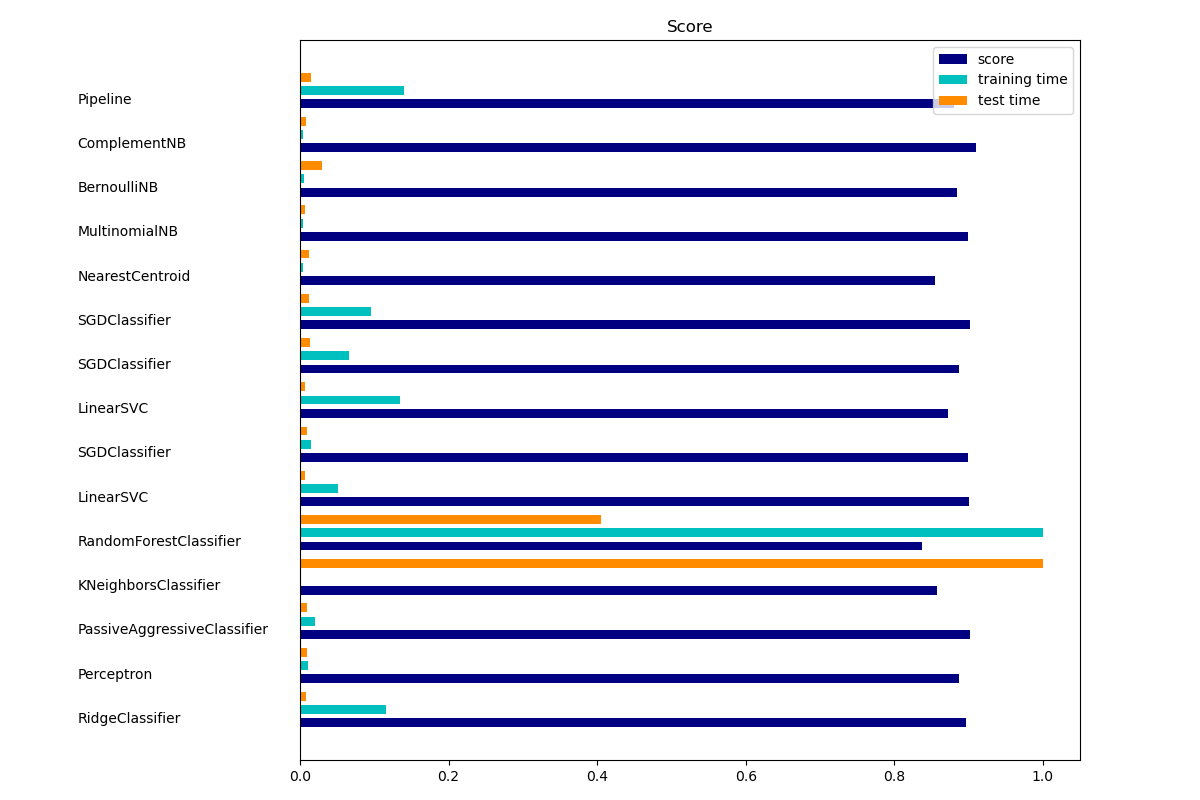sklearn.naive_bayes.ComplementNB¶
class sklearn.naive_bayes.ComplementNB(*,alpha = 1.0,fit_prior = True,class_prior = None,norm = False )
[源码]
在Rennie et al. (2003)中描述的补充朴素贝叶斯分类器。
补充朴素贝叶斯分类器旨在纠正标准多项朴素贝叶斯分类器所做的“严重假设”。它特别适合用于不平衡的数据集。
在用户指南中阅读更多内容。
0.20版中的新功能。
| 参数 | 说明 |
|---|---|
| alpha | float, default=1.0 附加的(Laplace/Lidstone)平滑参数(0表示不平滑) |
| fit_prior | bool, default=True 是否学习类别先验概率。如果为False,将使用统一的先验。 |
| class_prior | array-like of shape (n_classes,), default=None 类别的先验概率。一经指定先验概率不能随着数据而调整。 |
| norm | bool, default=False 是否对权重进行第二次标准化。默认行为反映了Mahout和Weka中的实现,这些实现未遵循本文表9中描述的完整算法。 |
| 属性 | 说明 |
|---|---|
| class_count_ | ndarray of shape (n_classes,) 拟合期间每个类别遇到的样本数。此值由提供的样本权重加权。 |
| class_log_prior_ | ndarray of shape (n_classes,) 每个类别的对数概率(平滑)。 |
| classes_ | ndarray of shape (n_classes,) 分类器已知的类别标签 |
| feature_all_ | ndarray of shape (n_features,) 拟合期间每个特征遇到的样本数。此值由提供的样本权重加权。 |
| feature_count_ | ndarray of shape (n_classes, n_features) 拟合期间每个(类别,特征)遇到的样本数。此值由提供的样本权重加权。 |
| feature_log_prob_ | ndarray of shape (n_classes, n_features) 类别补充的经验权重 |
| n_features_ | int 每个样本的特征数量。 |
参考文献
Rennie, J. D., Shih, L., Teevan, J., & Karger, D. R. (2003). Tackling the poor assumptions of naive bayes text classifiers. In ICML (Vol. 3, pp. 616-623). https://people.csail.mit.edu/jrennie/papers/icml03-nb.pdf
示例
>>> import numpy as np
>>> rng = np.random.RandomState(1)
>>> X = rng.randint(5, size=(6, 100))
>>> y = np.array([1, 2, 3, 4, 5, 6])
>>> from sklearn.naive_bayes import ComplementNB
>>> clf = ComplementNB()
>>> clf.fit(X, y)
ComplementNB()
>>> print(clf.predict(X[2:3]))
[3]
方法
| 方法 | 说明 |
|---|---|
fit(X, y[, sample_weight]) |
根据X,y拟合朴素贝叶斯分类器 |
get_params([deep]) |
获取这个估计器的参数 |
partial_fit(X, y[, classes, sample_weight]) |
对一批样本进行增量拟合 |
predict(X) |
对测试向量X进行分类。 |
predict_log_proba(X) |
返回针对测试向量X的对数概率估计 |
predict_proba(X) |
返回针对测试向量X的概率估计 |
score(X, y[, sample_weight]) |
返回给定测试数据和标签上的平均准确率。 |
set_params(**params) |
为这个估计器设置参数 |
__init__(*, alpha=1.0, fit_prior=True, class_prior=None, norm=False)
[源码]
初始化self。详情可参阅 type(self)的帮助。
fit(X, y, sample_weight=None)
[源码]
根据X,y拟合朴素贝叶斯分类器
| 参数 | 说明 |
|---|---|
| X | {array-like, sparse matrix} of shape (n_samples, n_features) 用于训练的向量,其中n_samples是样本数量,n_features是特征数量。 |
| y | array-like of shape (n_samples,) 目标值 |
| sample_weight | array-like of shape (n_samples,), default=None 应用于单个样本的权重(1.未加权)。 |
| 返回值 | 说明 |
|---|---|
| self | object |
get_params(deep=True)
[源码]
获取这个估计器的参数
| 参数 | 说明 |
|---|---|
| deep | bool, default=True 如果为True,则将返回这个估计器的参数和所包含的估计器子对象。 |
| 返回值 | 说明 |
|---|---|
| params | mapping of string to any 参数名称映射到其值。 |
partial_fit(X, y, classes=None, sample_weight=None)
[源码]
对一批样本进行增量拟合
方法需要对数据集的不同块连续调用多次,以实现核外学习或在线学习。
当整个数据集太大而无法立即放入内存拟合时,这个功能特别有用。
这个方法具有一些性能消耗,因此最好对尽可能大的数据块(只要适合内存预算)调用partial_fit以隐藏消耗。
| 参数 | 说明 |
|---|---|
| X | {array-like, sparse matrix} of shape (n_samples, n_features) 用于训练的向量,其中n_samples是样本数量,n_features是特征数量。 |
| y | array-like of shape (n_samples,) 目标值。 |
| classes | array-like of shape (n_classes), default=None y向量中可能出现的所有类别的列表。 必须在第一次调用partial_fit时提供,在随后的调用中可以省略。 |
| sample_weight | array-like of shape (n_samples,), default=None 应用于单个样本的权重(1.未加权)。 |
| 返回值 | 说明 |
|---|---|
| self | object |
predict(X)
[源码]
对测试向量X进行分类。
| 参数 | 说明 |
|---|---|
| X | array-like of shape (n_samples, n_features) |
| 返回值 | 说明 |
|---|---|
| C | ndarray of shape (n_samples,) X的预测目标值 |
predict_log_proba(X)
[源码]
返回测试向量X的对数概率估计。
| 参数 | 说明 |
|---|---|
| X | array-like of shape (n_samples, n_features) |
| 返回值 | 说明 |
|---|---|
| C | array-like of shape (n_samples, n_classes) 返回模型中每个类别的样本的对数概率。这些列按照排序顺序对应于类别,就像它们出现在属性classes_中一样。 |
predict_proba(X)
[源码]
| 参数 | 说明 |
|---|---|
| X | array-like of shape (n_samples, n_features) |
| 返回值 | 说明 |
|---|---|
| C | array-like of shape (n_samples, n_classes) 返回模型中每个类别的样本概率。这些列按照排序顺序对应于类别,就像它们出现在属性classes_中一样。 |
score(X, y, sample_weight=None)
[源码]
返回给定测试数据和标签上的平均准确度。
在多标签分类中,这是子集准确性,这是一个严格的指标,因为您需要为每个样本正确预测每个标签集。
| 参数 | 说明 |
|---|---|
| X | array-like of shape (n_samples, n_features) 测试样本 |
| y | array-like of shape (n_samples,) or (n_samples, n_outputs) X的真实值标签 |
| sample_weight | array-like of shape (n_samples,), default=None 样本权重 |
| 返回值 | 说明 |
|---|---|
| score | float self.predict(X)关于y的平均准确率 |
set_params(**params)
[源码]
| 参数 | 说明 |
|---|---|
| **params | dict 估计器参数 |
| 返回值 | 说明 |
|---|---|
| self | object 估计器实例 |





